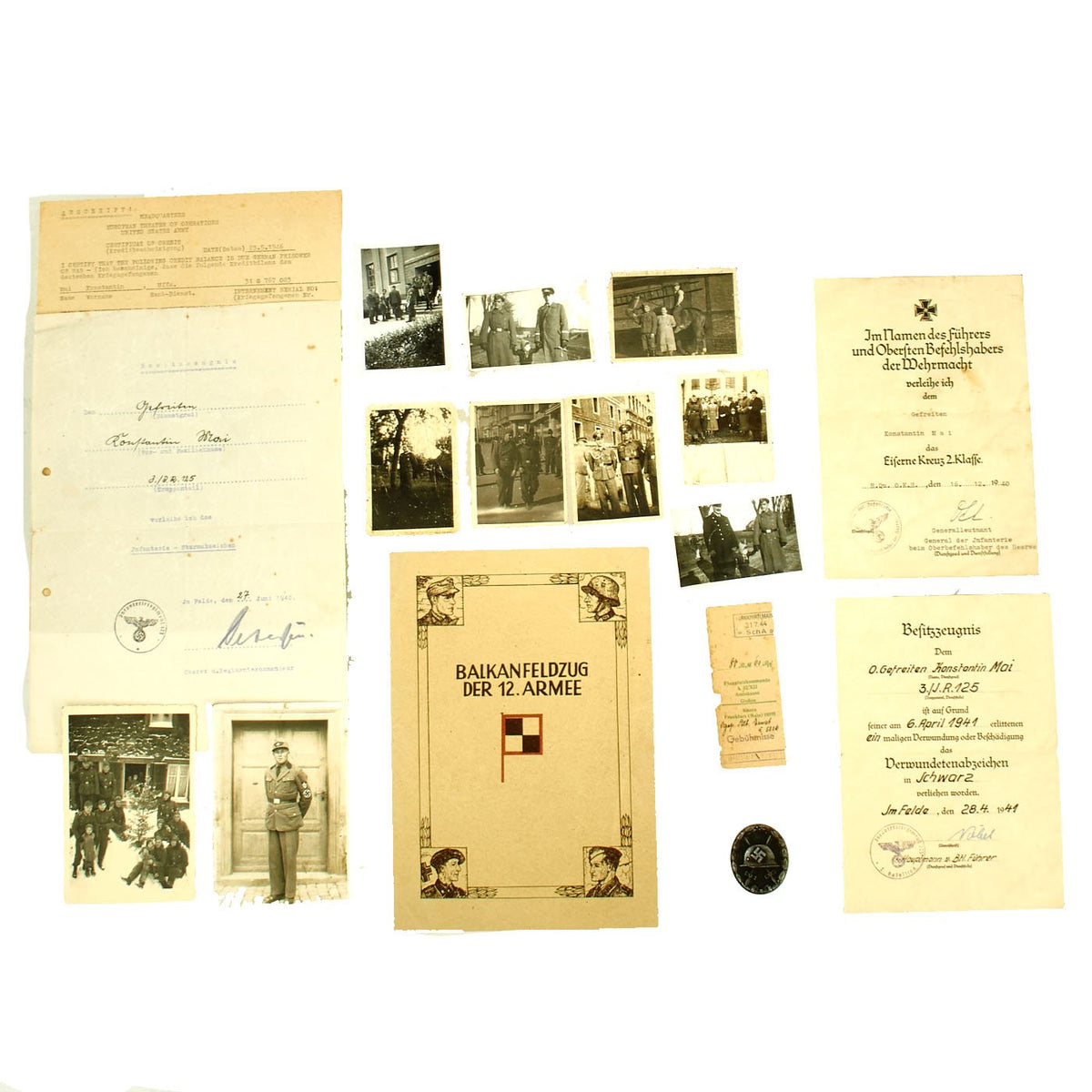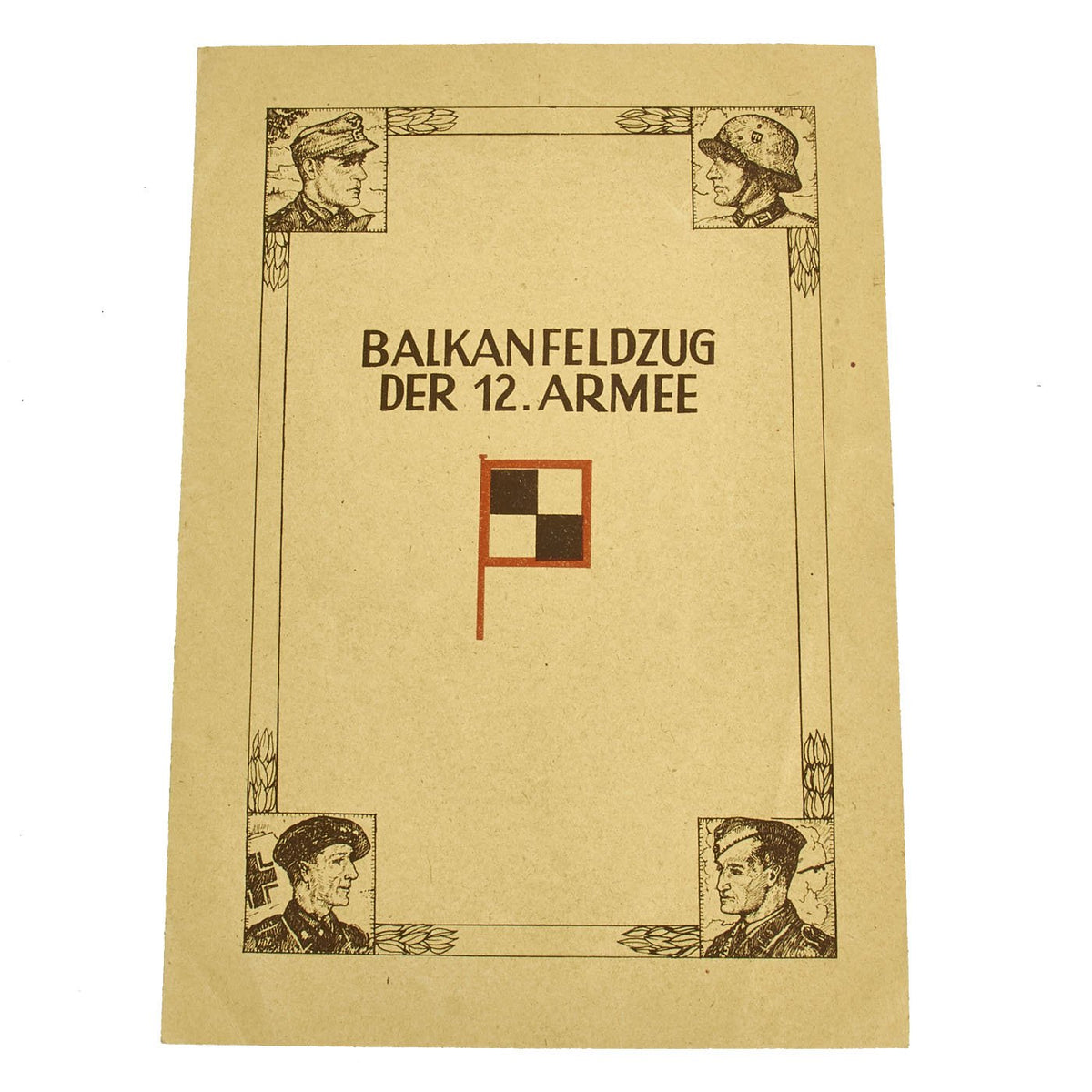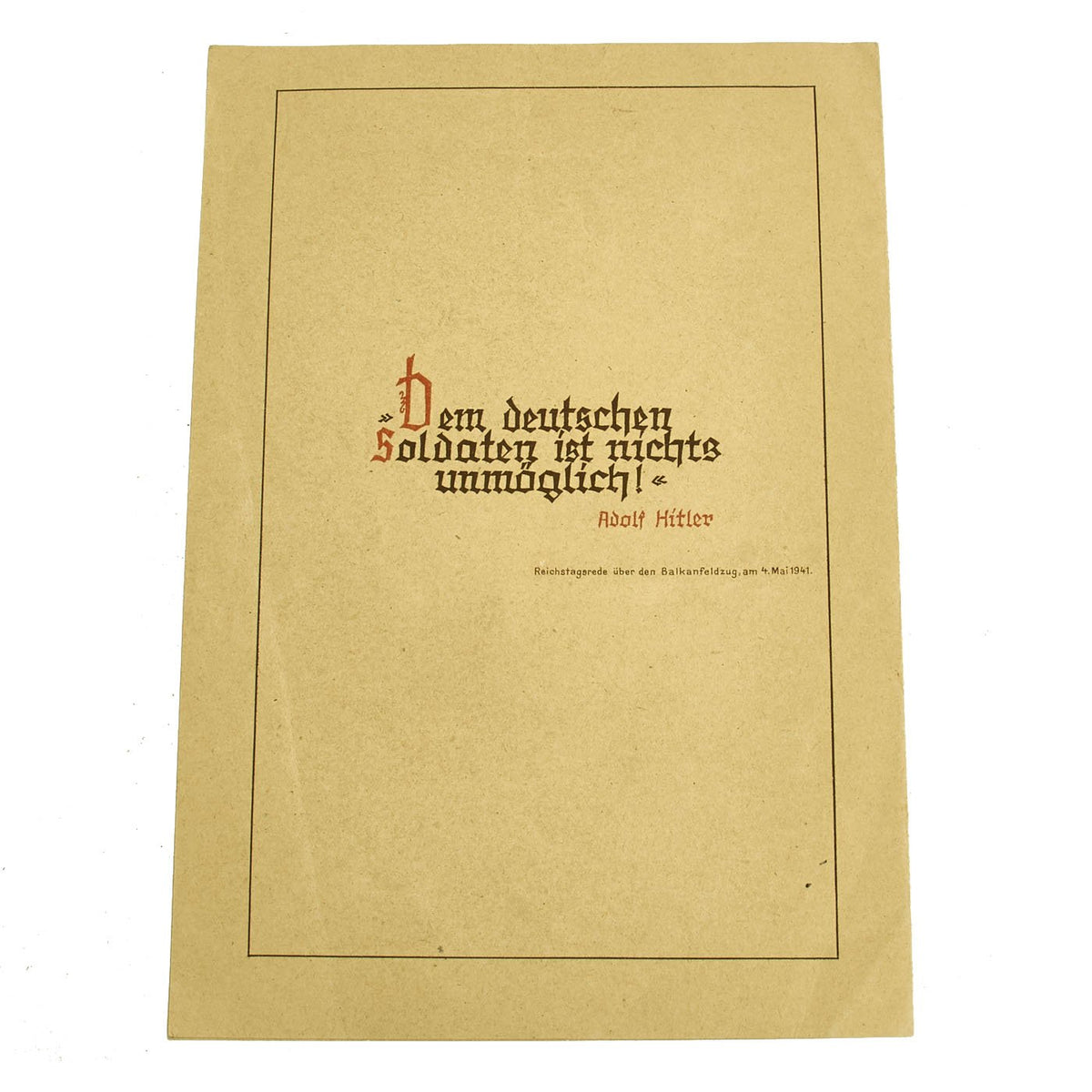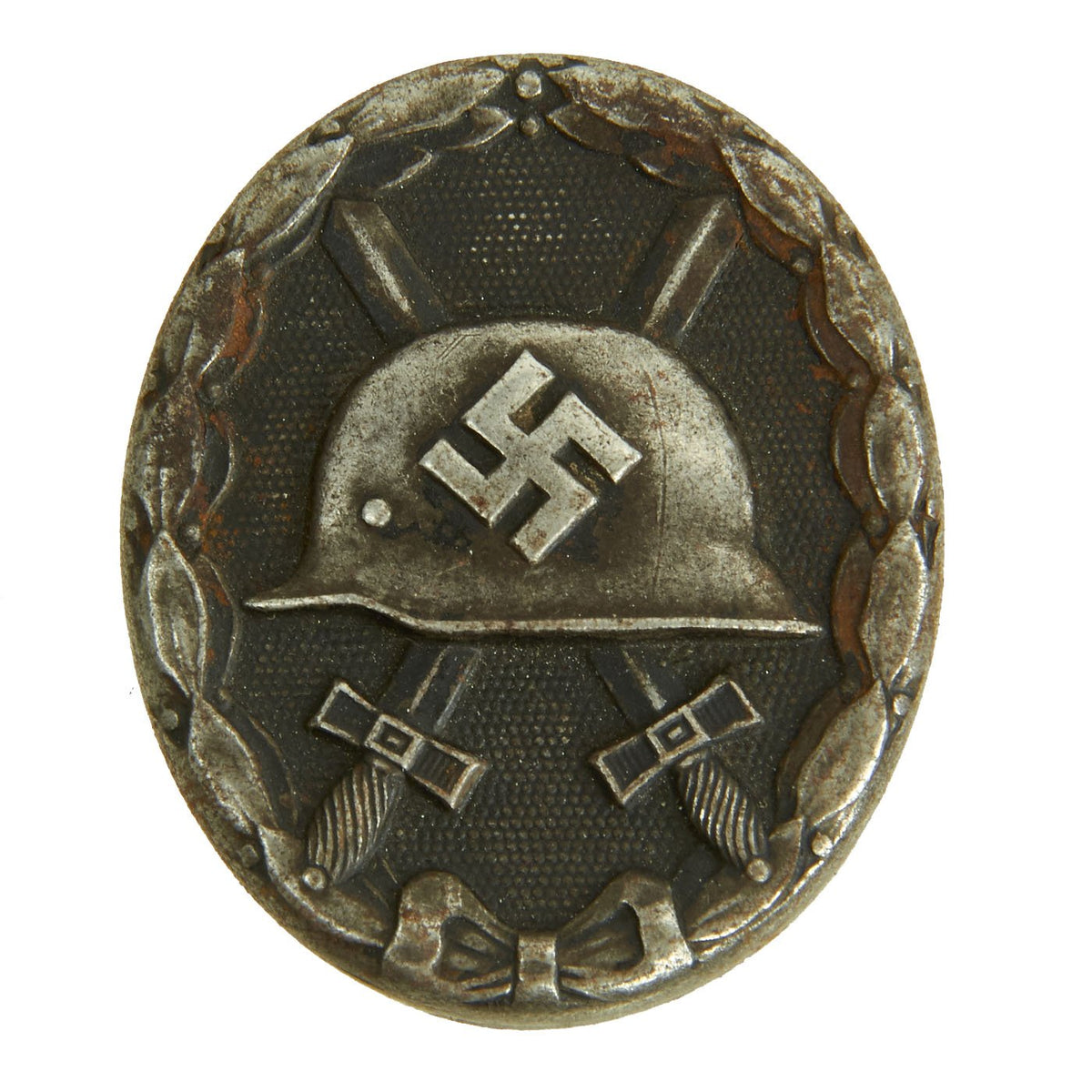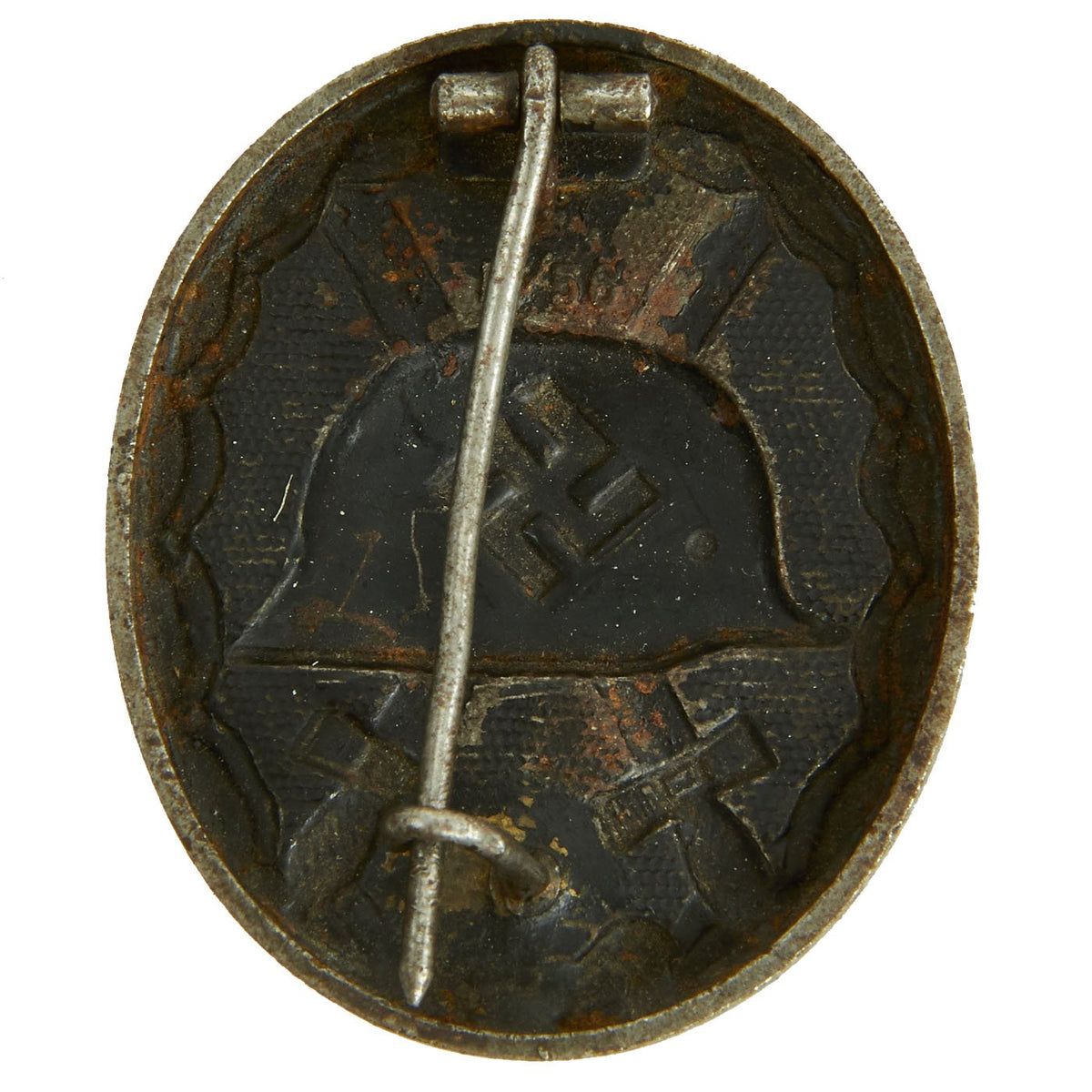Original German WWII Balkan Campaign Documents & Pictures Grouping of Obergefreiter Konstantin Mai Original Items
$ 495,00 $ 148,50
Original Items: One-of-a-kind grouping. This is a fantastic set, with three original German WWII combat award BESITTZZEUGNIS “possession/award” certificates, along with a Black Wound Badge. All were awarded to the same soldier, Konstantin Mai, holding the rank of Gefreiter and later Obergefreiter. There is also an Allied P.O.W. document, giving details of Mai’s internment during and following the war, which list him as an Unteroffizier (Sergeant). The award documents are dated 1940, 1940, and 1941, while the P.O.W. document is dated around 1944, making this a great set showing the progression of a “Senior Enlisted” level soldier, who progressed to becoming an NCO before his capture.
Per the award documents, he was a member of the 3. / J.R. 125 (3rd Company Infantry Regiment 125), which is the unit he looks to have been a part of throughout the war. There is included printed out research (partially in German) related to this unit and its service during the war. This unit had been part of the 12th Armee during the Balkan Campaigns, and there is a Commemorative booklet included that was given to soldiers who partook in the operation. The 125th would also serve in Greece as well as El Alamein.
There are 10 photographs included of various people. We unfortunately have not been able to identify which, if any, are Konstantin Mai, but there appear to be the same people appearing in the various photographs. There is writing on the back of some, as shown.
The three awards earned by this soldier (in date order) are the Infanterie-Sturmabzeichen (Infantry Assault Badge), the Eisernes Kreuz II. Klasse 1939 (Iron Cross 2nd Class 1939), and finally the Verwundetenabzeichen (Wound Badge) 3rd Class in Schwarz (Black). Two of the documents measure approximately, 8″ x 5.5″, (20cm x 14cm), and are printed on mid-weight paper with black print and typed in particulars. The Infantry Assault badge was awarded with a larger 8 1/4″ x 11 1/2″ document, which is lightweight paper, and was awarded in the field. All of the documents are dated, with their correct stamps and signatures.
The Iron Cross 2nd class was signed by Generalleutnant Eugen Ott, who was awarded the Knight’s Cross of the Iron Cross on 25 December 1942 as General der Infanterie and commander of LII. Armeekorps. He held this position 10 December 1941 – 20 November 1943, though there is no information what his post was after 1943.
The P.O.W. certificate, dated 23.5.1946, indicates that Unteroffizier Konstantin Mai was interned from 20.11.44. to 31.5.1946, and gives further details of his time in the P.O.W. camp. Unfortunately there is no information regarding the circumstances of his capture. There is some writing on the back, which we were not able to decipher.
All documents are in good condition, with the expected wear and yellowing from age. They all show some folding and tearing, as expected of documents of this age. Please consult the pictures for condition specifics.
A really nice German WWII Document & Photo set, complete with many original documents named to the same soldier. A great bit of history, showing a soldier’s progression over the years of the war, and eventual capture. Ready to research and display!
The Infantry Assault Badge (German: Infanterie-Sturmabzeichen) was a German war badge awarded to Waffen-SS and Wehrmacht Heer soldiers during the Second World War. This decoration was instituted on 20 December 1939 by the Commander-in-Chief of the German Army, Generalfeldmarschall Walther von Brauchitsch. It could be awarded to members of non-motorized Infantry units and units of the Gebirgsjäger that had participated in infantry assaults, with light infantry weapons, on at least three separate days of battle in the front line on or after 1 January 1940. When a counter offensive led to fighting, it could also apply. Award of the Infantry Assault Badge was authorized at regimental command level.
There is no more iconic German military award than the Iron Cross. The long history of this order began during the Napoleonic Wars. King Friedrich Wilhelm III of Prussia instituted the “Eisernes Kreuz” (Iron Cross) in March of 1813. The award criteria changed somewhat with time, but generally speaking, Iron Crosses could be awarded for individual acts of bravery, or for leadership achievements on the battlefield. The design was created by a Karl Friedrich Schinkel, his choice of the black cross with silver outline was derived from the heraldic emblem of the Teutonic Knights.
The final reinstitution of the cross came in 1939. For this version, the front of the core for both grades bore a swas and the date 1939. The oak leaves, crown and royal initials were removed from the reverse, with only the date 1813 remaining as a reminder of the legacy of this award. In WWII, hundreds of thousands of Iron Cross First Class awards were bestowed, and four and a half million Iron Cross Second Class awards. Iron Crosses were made by a large number of authorized manufacturers. Some variants of these awards were mass produced in huge numbers. Others were made in very limited quantities.
The Wound Badge (German: Verwundetenabzeichen) was a military decoration first promulgated by Wilhelm II, German Emperor on 3 March 1918, which was awarded to wounded or frostbitten soldiers of the Imperial German Army, during World War I. Between the world wars, it was awarded to members of the German armed forces who fought on the Nationalist side of the Spanish Civil War, 1938–39, and received combat related wounds. It was awarded to members in the Reichswehr, the Wehrmacht, SS and the auxiliary service organizations during the Second World War. After March 1943, due to the increasing number of Allied bombings, it was also awarded to wounded civilians in air raids. It was awarded when the wound was the result of enemy hostile action, with an exception being for frostbite.
The badge had three classes:
– Black (3rd class, representing Iron), for those wounded once or twice by hostile action (including air raids).
– Silver (2nd class) for being wounded three or four times.
– Gold (1st class, which could be awarded posthumously) for five or more times wounded.
The “progression” could be waived in the event of loss of a limb or eyesight; when such a severe wound occurred, the silver badge was awarded.
Fast Shipping with Professional Packaging
Thanks to our longstanding association with UPS FedEx DHL, and other major international carriers, we are able to provide a range of shipping options. Our warehouse staff is expertly trained and will wrap your products according to our exact and precise specifications. Prior to shipping, your goods will be thoroughly examined and securely secured. We ship to thousands clients each day across multiple countries. This shows how we're dedicated to be the largest retailer on the internet. Warehouses and distribution centres can be located throughout Europe as well as the USA.
Note: Orders with more than one item will be assigned a processing date depending on the item.
Before shipping before shipping, we'll conduct a thorough inspection of the items you have ordered. Today, the majority of orders will be delivered within 48 hours. The delivery time will be between 3-7 days.
Returns
The stock is dynamic and we cannot completely manage it because multiple stakeholders are involved, including our factory and warehouse. So the actual stock may alter at any time. It's possible that you may not receive your order once the order has been made.
Our policy is valid for a period of 30 days. If you don't receive the product within 30 days, we are not able to issue a refund or an exchange.
You can only return an item if it is unused and in the same state as the day you received it. You must have the item in its original packaging.
Related products
Uncategorized
Armored Burgonet Helmet & Polearm from Scottish Castle Leith Hall Circa 1700 Original Items
Uncategorized
Uncategorized
Australian WWII Owen MK1 Machine Carbine SMG Custom Fabricated Replica with Sling Original Items
Uncategorized
Uncategorized
Uncategorized
Uncategorized
Band of Brothers ORIGINAL GERMAN WWII Le. F.H. 18 10.5cm ARTILLERY PIECE Original Items
Uncategorized
Uncategorized
Uncategorized
Angolan Rebel 1970s era 60mm Inert Display Mortar from Angolan Civil War Original Items
Uncategorized
Uncategorized
Uncategorized
Uncategorized
Uncategorized
Uncategorized
Armoured Fighting Vehicles of the World: AFVs of World War One (Hardcover Book) New Made Items
Uncategorized
Uncategorized
Uncategorized
